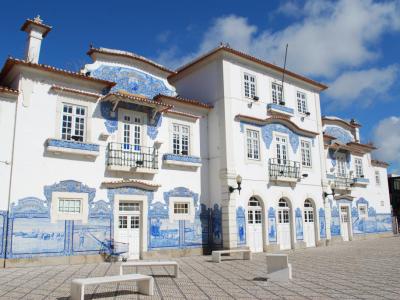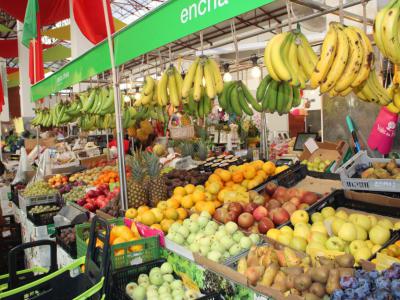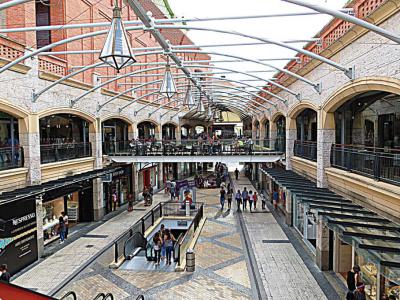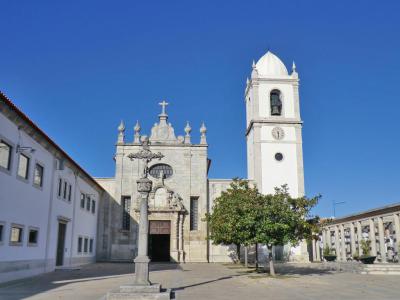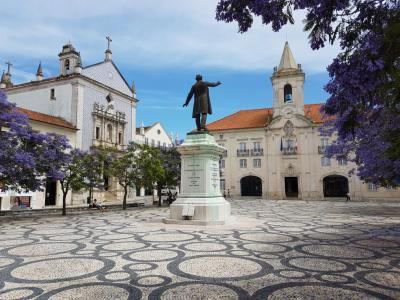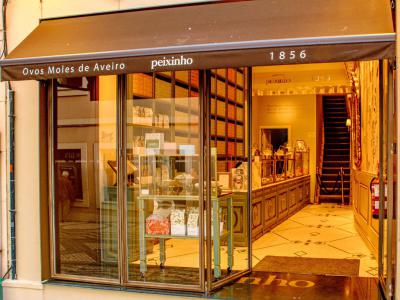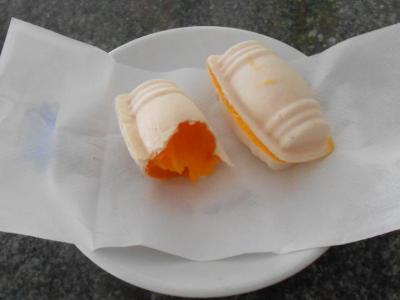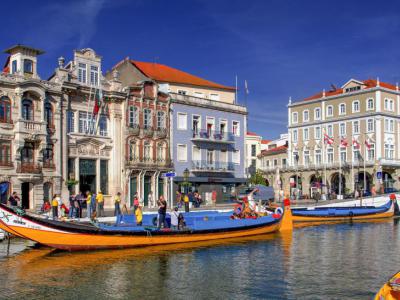Aveiro Introduction Walking Tour (Self Guided), Aveiro
Aveiro, nicknamed the "Venice of Portugal," is a charming and distinctive destination just a day trip away from Porto. Much loved by locals, its coastal location draws summer crowds to nearby beaches, yet its rich heritage and lively culture allure visitors year-round. With its picturesque maze of colorful canals and boats, Aveiro is undoubtedly one of Portugal's most romantic getaways.
The evidence of human settlement here dates back to prehistoric times. The name "Averius" originated from the Celtic word "aber," which means river-mouth and reflects the area's geographical features. Over the centuries, Aveiro flourished as a vital hub for salt production and maritime trade, attracting attention from the Romans, Middle Ages merchants, and ultimately Portuguese royalty, cementing its significance in Portugal's economic and cultural landscape.
In the early 15th century, King João I secured the settlement with fortification walls. King Edward Duarte, in turn, granted Aveiro the privilege of an annual duty-free fair in 1435, known since as the March Fair (Feira de Março). Princess Joana's residence in Aveiro and her patronage further contributed to its development. In 1515, Manuel I of Portugal granted the town its first charter, and King José I elevated Aveiro to city status in 1759.
In the 19th century, the city largely benefited from transport evolution, notably the railway line between Lisbon and Porto. The opening of the artificial canals, completed in 1808, allowed Aveiro to expand economically, adding momentum to its growth.
One of the top local landmarks is the Aveiro Railway Station at the outset of Doctor Lourenco Peixinho Avenue. This station harmoniously blends a beautifully preserved 1864 building adorned with intricate azulejos tiles with a sleek, contemporary structure erected in 2005 to cater to travelers' needs.
The Aveiro Cathedral, with its notable façade elements and other artistic treasures, stands as a testament to the city's religious heritage.
History enthusiasts will delight in exploring the Aveiro Museum, housed in the former Convento de Jesus.
And of course, a leisurely cruise along Aveiro's Central Canal, the city's main water artery, is a must. Connecting cultural and leisure hubs while offering scenic strolls alongside Art Nouveau architecture and traditional Moliceiro boat tours, it makes a prime tourist attraction.
For a more detailed acquaintance with Aveiro, embark on an unforgettable journey filled with history, culture, and culinary delights. Our self-guided tour will help you uncover the wonders of this captivating Portuguese coastal gem!
The evidence of human settlement here dates back to prehistoric times. The name "Averius" originated from the Celtic word "aber," which means river-mouth and reflects the area's geographical features. Over the centuries, Aveiro flourished as a vital hub for salt production and maritime trade, attracting attention from the Romans, Middle Ages merchants, and ultimately Portuguese royalty, cementing its significance in Portugal's economic and cultural landscape.
In the early 15th century, King João I secured the settlement with fortification walls. King Edward Duarte, in turn, granted Aveiro the privilege of an annual duty-free fair in 1435, known since as the March Fair (Feira de Março). Princess Joana's residence in Aveiro and her patronage further contributed to its development. In 1515, Manuel I of Portugal granted the town its first charter, and King José I elevated Aveiro to city status in 1759.
In the 19th century, the city largely benefited from transport evolution, notably the railway line between Lisbon and Porto. The opening of the artificial canals, completed in 1808, allowed Aveiro to expand economically, adding momentum to its growth.
One of the top local landmarks is the Aveiro Railway Station at the outset of Doctor Lourenco Peixinho Avenue. This station harmoniously blends a beautifully preserved 1864 building adorned with intricate azulejos tiles with a sleek, contemporary structure erected in 2005 to cater to travelers' needs.
The Aveiro Cathedral, with its notable façade elements and other artistic treasures, stands as a testament to the city's religious heritage.
History enthusiasts will delight in exploring the Aveiro Museum, housed in the former Convento de Jesus.
And of course, a leisurely cruise along Aveiro's Central Canal, the city's main water artery, is a must. Connecting cultural and leisure hubs while offering scenic strolls alongside Art Nouveau architecture and traditional Moliceiro boat tours, it makes a prime tourist attraction.
For a more detailed acquaintance with Aveiro, embark on an unforgettable journey filled with history, culture, and culinary delights. Our self-guided tour will help you uncover the wonders of this captivating Portuguese coastal gem!
How it works: Download the app "GPSmyCity: Walks in 1K+ Cities" from Apple App Store or Google Play Store to your mobile phone or tablet. The app turns your mobile device into a personal tour guide and its built-in GPS navigation functions guide you from one tour stop to next. The app works offline, so no data plan is needed when traveling abroad.
Aveiro Introduction Walking Tour Map
Guide Name: Aveiro Introduction Walking Tour
Guide Location: Portugal » Aveiro (See other walking tours in Aveiro)
Guide Type: Self-guided Walking Tour (Sightseeing)
# of Attractions: 12
Tour Duration: 2 Hour(s)
Travel Distance: 2.5 Km or 1.6 Miles
Author: DanaOffice
Sight(s) Featured in This Guide:
Guide Location: Portugal » Aveiro (See other walking tours in Aveiro)
Guide Type: Self-guided Walking Tour (Sightseeing)
# of Attractions: 12
Tour Duration: 2 Hour(s)
Travel Distance: 2.5 Km or 1.6 Miles
Author: DanaOffice
Sight(s) Featured in This Guide:
- Aveiro Railway Station
- Avenida do Doutor Lourenco Peixinho (Doctor Lourenco Peixinho Avenue)
- Mercado Manuel Firmino (Manuel Firmino Market)
- Forum Aveiro
- Cattedrale di Aveiro (Aveiro Cathedral)
- Museu de Aveiro (Aveiro Museum)
- Praca da Republica (Republic Square)
- Confeitaria Peixinho (Peixinho Confectionery)
- Delgado Square and Bridge Statues
- Oficina do Doce (Sweet Workshop)
- Art Nouveau Museum
- Canal Central de Aveiro (Central Canal of Aveiro)
1) Aveiro Railway Station (must see)
Aveiro Railway Station comprises two distinct buildings, each contributing to the station's unique character. The older structure, dating back to 1864, stands as a testament to the city's rich history, adorned with captivating azulejos tiles that showcase scenes of life in Aveiro during the last century.
These finely crafted tiles depict various aspects of Aveiro, capturing scenes such as the serene Rio Vouga, the distinguished Palace Hotel Bussaco, industrious fishermen engaged in their work on moliceiros boats, and the historic Monastery of Jesus, which has transformed into the present-day Museum of Aveiro. Each tile is a piece of art, offering a glimpse into the city's cultural heritage and local life.
Adjacent to the historic structure, a new station building, characterized by its striking plain white design, was erected in 2005. This modern facility has since taken on the role of Aveiro's primary railway station, efficiently serving the needs of travelers. While the new station handles the practical aspects of transportation, the old Aveiro Station has been meticulously preserved, inviting visitors to immerse themselves in the architectural and artistic splendor of a bygone era.
A visit to Aveiro Railway Station is a captivating experience, where the old and the new seamlessly coexist. The old station, with its azulejo-clad exterior, stands as a cultural gem, offering a glimpse into Aveiro's past, while the modern building ensures the smooth functioning of contemporary rail travel.
These finely crafted tiles depict various aspects of Aveiro, capturing scenes such as the serene Rio Vouga, the distinguished Palace Hotel Bussaco, industrious fishermen engaged in their work on moliceiros boats, and the historic Monastery of Jesus, which has transformed into the present-day Museum of Aveiro. Each tile is a piece of art, offering a glimpse into the city's cultural heritage and local life.
Adjacent to the historic structure, a new station building, characterized by its striking plain white design, was erected in 2005. This modern facility has since taken on the role of Aveiro's primary railway station, efficiently serving the needs of travelers. While the new station handles the practical aspects of transportation, the old Aveiro Station has been meticulously preserved, inviting visitors to immerse themselves in the architectural and artistic splendor of a bygone era.
A visit to Aveiro Railway Station is a captivating experience, where the old and the new seamlessly coexist. The old station, with its azulejo-clad exterior, stands as a cultural gem, offering a glimpse into Aveiro's past, while the modern building ensures the smooth functioning of contemporary rail travel.
2) Avenida do Doutor Lourenco Peixinho (Doctor Lourenco Peixinho Avenue)
Doctor Lourenço Peixinho Avenue stands as the largest and widest thoroughfare in Aveiro. Bounded by the iconic Train Station building and Market Alley, the avenue offers a visual feast for anyone arriving in Aveiro by train. Its expansive layout stretches through the heart of the city, leading visitors to the oldest quarters of Aveiro. A lively and vibrant atmosphere envelops the avenue, adorned with an array of shops, cafes, and restaurants that cater to both locals and visitors.
Doctor Lourenço Peixinho Avenue has played a pivotal role in the city's evolution, with its development and expansion towards the northeast. The avenue has been witness to significant transformations during the 20th century, becoming the primary urban hub for services and commerce in Aveiro. Its construction, spanning from 1918 to 1935, marked a crucial period in the city's history, fostering growth and providing a central axis for various activities.
In 1943, the avenue received its current name in honor of Aveiro's esteemed figure, Lourenço Simões Peixinho. Serving as the president of the Aveiro City Council for an impressive 24 consecutive years (1918–1942), Peixinho was a key driving force behind the construction of this iconic boulevard.
Over the years, Avenida do Doutor Lourenço Peixinho has undergone several changes and renovations. The latest transformation, completed in May 2023, was a profound renovation that altered the road and pedestrian circulation. This modernization project included the removal of the central tree-lined median and an expansion of the sidewalks, enhancing the overall accessibility and aesthetics of the avenue.
Doctor Lourenço Peixinho Avenue has played a pivotal role in the city's evolution, with its development and expansion towards the northeast. The avenue has been witness to significant transformations during the 20th century, becoming the primary urban hub for services and commerce in Aveiro. Its construction, spanning from 1918 to 1935, marked a crucial period in the city's history, fostering growth and providing a central axis for various activities.
In 1943, the avenue received its current name in honor of Aveiro's esteemed figure, Lourenço Simões Peixinho. Serving as the president of the Aveiro City Council for an impressive 24 consecutive years (1918–1942), Peixinho was a key driving force behind the construction of this iconic boulevard.
Over the years, Avenida do Doutor Lourenço Peixinho has undergone several changes and renovations. The latest transformation, completed in May 2023, was a profound renovation that altered the road and pedestrian circulation. This modernization project included the removal of the central tree-lined median and an expansion of the sidewalks, enhancing the overall accessibility and aesthetics of the avenue.
3) Mercado Manuel Firmino (Manuel Firmino Market)
Manuel Firmino Market is a vibrant covered space offering a diverse array of products. Situated next to the picturesque Aveiro River, this market is a bustling hub for locals and visitors alike.
The market showcases an extensive range of goods, including vibrant flowers, fresh fruits, and crisp vegetables. A dedicated fish market operates from Tuesday to Saturday, creating a lively atmosphere with an interesting selection of the day's catch. In addition to seafood, visitors can explore stalls offering bread, cakes, cheese, cold cuts, lupins, olives, and more, often sourced directly from family farms, ensuring a remarkable balance between price and quality.
Throughout the week, the market is a lively scene, with Saturdays hosting special events in the surrounding area. On Saturdays, visitors can also discover organic farming products, adding an eco-friendly touch to the market's diverse offerings. The market is conveniently located, with good access to the city center and ample natural light, creating an inviting shopping experience.
Beyond the market's lively commerce, the space is home to several establishments, including the Maria Lounge Bar. Visitors can enjoy not only the vibrant market atmosphere but also the scenic views of moliceiros passing under the iconic Ponte dos Laços. The market's proximity to the Fórum Aveiro shopping center further enhances the area's appeal.
The market showcases an extensive range of goods, including vibrant flowers, fresh fruits, and crisp vegetables. A dedicated fish market operates from Tuesday to Saturday, creating a lively atmosphere with an interesting selection of the day's catch. In addition to seafood, visitors can explore stalls offering bread, cakes, cheese, cold cuts, lupins, olives, and more, often sourced directly from family farms, ensuring a remarkable balance between price and quality.
Throughout the week, the market is a lively scene, with Saturdays hosting special events in the surrounding area. On Saturdays, visitors can also discover organic farming products, adding an eco-friendly touch to the market's diverse offerings. The market is conveniently located, with good access to the city center and ample natural light, creating an inviting shopping experience.
Beyond the market's lively commerce, the space is home to several establishments, including the Maria Lounge Bar. Visitors can enjoy not only the vibrant market atmosphere but also the scenic views of moliceiros passing under the iconic Ponte dos Laços. The market's proximity to the Fórum Aveiro shopping center further enhances the area's appeal.
4) Forum Aveiro
Forum Aveiro, inaugurated on September 29th, 1998, holds the distinction of being Portugal's pioneer open-air shopping center. Nestled in the heart of Aveiro's city center, Forum Aveiro introduced an innovative shopping center concept to the country, prioritizing gardens, green spaces, and public areas. Renowned for its unique architecture and seamless integration with the surrounding environment, this shopping destination offers an exceptional blend of retail therapy, dining, entertainment, and scenic landscapes.
One of Forum Aveiro's distinguishing features is its classic stone architecture, creating an open-air shopping mall with over 70 retail shops. The first floor hosts an array of stores catering to diverse needs, including accessories, sports, games, optics, music, books, cosmetics, perfumes, and renowned clothing brands like Mango and Zara.
Beyond the shopping opportunities, Forum Aveiro offers a delightful food court on the second level, presenting a diverse culinary landscape. The food court boasts 11 restaurants: from hamburger joints and wok-to-go options to Pizzahut and Portuguese restaurants, visitors can savor a variety of flavors. The mall exudes a good vibe, and the staff is known for their helpful and friendly demeanor, contributing to a pleasant overall experience.
One of Forum Aveiro's distinguishing features is its classic stone architecture, creating an open-air shopping mall with over 70 retail shops. The first floor hosts an array of stores catering to diverse needs, including accessories, sports, games, optics, music, books, cosmetics, perfumes, and renowned clothing brands like Mango and Zara.
Beyond the shopping opportunities, Forum Aveiro offers a delightful food court on the second level, presenting a diverse culinary landscape. The food court boasts 11 restaurants: from hamburger joints and wok-to-go options to Pizzahut and Portuguese restaurants, visitors can savor a variety of flavors. The mall exudes a good vibe, and the staff is known for their helpful and friendly demeanor, contributing to a pleasant overall experience.
5) Cattedrale di Aveiro (Aveiro Cathedral) (must see)
Saint Dominic's Cathedral, also known as Aveiro Cathedral, holds a central position as the primary Catholic church. Originating as part of the Dominican Monastery of Our Lady of Mercy of Aveiro, founded in 1423, the church underwent significant transformations over the centuries.
Originally constructed on the outskirts of the village with three naves and a main chapel, the church experienced expansions and enhancements between the 16th and 17th centuries. The side naves were transformed into chapels for stability, and subsequent renovations in the 18th century embraced the Baroque style. A bell tower stands against the façade, and a delicate Art Nouveau-style dome crowns the crossing of the transept, reflecting the 20th-century modifications by Portuguese architect Abrunhosa de Brito.
The façade, characterized by Mannerist elements, features a notable baroque door adorned with double columns and a tympanum representing figures of Faith, Hope, and Charity. Inside, the single nave displays 18th-century azulejos from the Coimbra cycle by Sousa Carvalho, depicting scenes related to Saint Dominic's life and episodes of the Marian liturgy.
The church houses two stone pulpits within the nave and notable side chapels from the Baroque period. Noteworthy elements include the tombs of Catarina de Ataíde, a stone retable representing the Visitation, and the Cross of Saint Domenico (late 15th century) in the first chapel on the left. The funerary chapel of João de Albuquerque and Renaissance-style paintings on the vaults in the apse chapels add further artistic richness. The main altar features an alabaster virgin from Nottingham within a rococo polychrome retable sourced from a demolished church.
Originally constructed on the outskirts of the village with three naves and a main chapel, the church experienced expansions and enhancements between the 16th and 17th centuries. The side naves were transformed into chapels for stability, and subsequent renovations in the 18th century embraced the Baroque style. A bell tower stands against the façade, and a delicate Art Nouveau-style dome crowns the crossing of the transept, reflecting the 20th-century modifications by Portuguese architect Abrunhosa de Brito.
The façade, characterized by Mannerist elements, features a notable baroque door adorned with double columns and a tympanum representing figures of Faith, Hope, and Charity. Inside, the single nave displays 18th-century azulejos from the Coimbra cycle by Sousa Carvalho, depicting scenes related to Saint Dominic's life and episodes of the Marian liturgy.
The church houses two stone pulpits within the nave and notable side chapels from the Baroque period. Noteworthy elements include the tombs of Catarina de Ataíde, a stone retable representing the Visitation, and the Cross of Saint Domenico (late 15th century) in the first chapel on the left. The funerary chapel of João de Albuquerque and Renaissance-style paintings on the vaults in the apse chapels add further artistic richness. The main altar features an alabaster virgin from Nottingham within a rococo polychrome retable sourced from a demolished church.
6) Museu de Aveiro (Aveiro Museum) (must see)
The Aveiro Museum / Santa Joana, finds its home in the former Convent of Jesus of the female Dominican Order, a historic site founded by a papal bull in 1461. This convent served as the residence for Princess Joana of Portugal, daughter of Afonso V, who entered the convent in 1472. Renowned for her life of holiness, Princess Joana was beatified in 1693 and is now the patron saint of Aveiro, with the city commemorating her on May 12th, the day of her birth and death.
The convent underwent significant renovations between the 16th and 18th centuries, with improvements continuing until 1874 when the enclosure was maintained. In 1911, the convent was transformed into the Museum of Aveiro / Santa Joana. In 2006, Architect Alcino Soutinho undertook a reformulating intervention to enhance the building's structure.
The museum houses a remarkable collection of religious art spanning from the 15th to the 20th century, with a particular emphasis on the Baroque period. Notable highlights include a portrait of Princess Joana, the Tomb, and the Church of Jesus. One of the iconic sculptures within the museum is the "Fácies Christi," a representation of the crucified Christ in the High Choir. This sculpture is renowned for its unique feature where the Face appears to display a smiling expression on one side and a sad expression on the other, making it a distinctive and significant piece within the museum's collection.
The convent underwent significant renovations between the 16th and 18th centuries, with improvements continuing until 1874 when the enclosure was maintained. In 1911, the convent was transformed into the Museum of Aveiro / Santa Joana. In 2006, Architect Alcino Soutinho undertook a reformulating intervention to enhance the building's structure.
The museum houses a remarkable collection of religious art spanning from the 15th to the 20th century, with a particular emphasis on the Baroque period. Notable highlights include a portrait of Princess Joana, the Tomb, and the Church of Jesus. One of the iconic sculptures within the museum is the "Fácies Christi," a representation of the crucified Christ in the High Choir. This sculpture is renowned for its unique feature where the Face appears to display a smiling expression on one side and a sad expression on the other, making it a distinctive and significant piece within the museum's collection.
7) Praca da Republica (Republic Square)
Republic Square is one of the main squares in Aveiro. The square is adorned with significant landmarks, contributing to the city's rich cultural and historical tapestry. Here, you'll find the Aveirense Theater, providing a venue for various artistic performances. The square is also home to the monument honoring José Coelho de Magalhães Estevão, a notable figure in Aveiro's history.
Dominating the square is the City Hall (District Council of Aveiro), a baroque building dating back to the late 18th century. The architectural charm of the building includes a distinctive bell tower, adding to the square's picturesque ambiance. Unfortunately, the City Hall is not open to visitors, but its exterior remains an architectural delight.
Another noteworthy structure on Republic Square is the Misericórdia Church, constructed in 1600. The church's entrance and its interior adorned with 17th-century tiles make it a captivating landmark.
Dominating the square is the City Hall (District Council of Aveiro), a baroque building dating back to the late 18th century. The architectural charm of the building includes a distinctive bell tower, adding to the square's picturesque ambiance. Unfortunately, the City Hall is not open to visitors, but its exterior remains an architectural delight.
Another noteworthy structure on Republic Square is the Misericórdia Church, constructed in 1600. The church's entrance and its interior adorned with 17th-century tiles make it a captivating landmark.
8) Confeitaria Peixinho (Peixinho Confectionery)
Confeitaria Peixinho, established in 1856, proudly asserts itself as the oldest soft egg house in Aveiro. Nestled near the picturesque Ria de Aveiro, this historic confectionery not only offers the iconic Ovos Moles but also presents an array of delectable pastries, with a special emphasis on soft egg-infused treats. Among the culinary delights, visitors can savor the unique Raivas from Aveiro, known for their delightful crunch and a harmonious blend of sweetness and saltiness.
Undergoing a renovation in 2018, Confeitaria Peixinho is adorned with decor inspired by Aveiro's new art. Stepping into the store, guests are greeted by a display featuring a first edition of the renowned work "Os Maias," a nod to the confectionery's signature product: "There are six barrels of soft eggs from Aveiro. It's a very famous sweet, even abroad. Only the one from Aveiro is chic." This historic establishment continues to charm visitors with its rich heritage and a tempting array of traditional Portuguese sweets.
Undergoing a renovation in 2018, Confeitaria Peixinho is adorned with decor inspired by Aveiro's new art. Stepping into the store, guests are greeted by a display featuring a first edition of the renowned work "Os Maias," a nod to the confectionery's signature product: "There are six barrels of soft eggs from Aveiro. It's a very famous sweet, even abroad. Only the one from Aveiro is chic." This historic establishment continues to charm visitors with its rich heritage and a tempting array of traditional Portuguese sweets.
9) Delgado Square and Bridge Statues
General Humberto Delgado Square, commonly referred to as Pontes (Bridges), holds a unique characteristic, having been constructed in the shape of a roundabout. It serves as a replacement for the previous connection facilitated by two bridges, namely the Bridge of the Arches and Bridge of Souls. The alternative name Bridges' Square reflect its role in bridging these waterways. Beyond its architectural appeal, the square serves as a vibrant venue for various events and celebrations. Notably, it hosts gatherings such as New Year's Eve festivities and the conclusion of sporting competitions.
One notable element of the square is the set of four bronze statues positioned at the four ends of the bridge over the Central Canal. Despite being smaller than life-size, these full-body statues capture the essence of traditional figures from Aveiro. The representation includes two figures from the working environment, the Salineira and Marnoto (Salt Workers), as well as two emblematic characters from festival days, the Parceira do Ramo (Branch Companion) and the Fogueteiro (Fireworks Enthusiast).
The Salineira statue showcases traditional attire with a canasta atop her head, symbolizing her role in the salt industry. The Marnoto statue depicts traditional work clothes and tools used in salt production, known as a galho. The Parceira do Ramo statue elegantly wears traditional female festival attire, adorned with a long shawl, holding a bouquet of flowers destined for the new butlers. Finally, the Fogueteiro statue, dressed in traditional Sunday clothes and a coat, dons buckled shoes and a cap while gripping a rocket in her left hand, representing a customary element of the festivities. These statues not only add cultural richness to the square but also pay homage to Aveiro's heritage and traditions.
One notable element of the square is the set of four bronze statues positioned at the four ends of the bridge over the Central Canal. Despite being smaller than life-size, these full-body statues capture the essence of traditional figures from Aveiro. The representation includes two figures from the working environment, the Salineira and Marnoto (Salt Workers), as well as two emblematic characters from festival days, the Parceira do Ramo (Branch Companion) and the Fogueteiro (Fireworks Enthusiast).
The Salineira statue showcases traditional attire with a canasta atop her head, symbolizing her role in the salt industry. The Marnoto statue depicts traditional work clothes and tools used in salt production, known as a galho. The Parceira do Ramo statue elegantly wears traditional female festival attire, adorned with a long shawl, holding a bouquet of flowers destined for the new butlers. Finally, the Fogueteiro statue, dressed in traditional Sunday clothes and a coat, dons buckled shoes and a cap while gripping a rocket in her left hand, representing a customary element of the festivities. These statues not only add cultural richness to the square but also pay homage to Aveiro's heritage and traditions.
10) Oficina do Doce (Sweet Workshop)
Sweet Workshop stands as an interactive exhibition and workshop dedicated to the creation of Ovos Moles (Soft Eggs), a traditional sweet of the region. Nestled within Galeria Rossio, this venue invites visitors to not only observe but actively participate in the making of Aveiro's renowned soft eggs. As you step in, the Sweet Workshop store greets you, leading to the demonstration area further inside. Engage in an enlightening video showcasing the meticulous artisanal process of crafting soft eggs, followed by a demonstration of the intricate molds encased in wafers.
Curious minds can find answers to all their questions about Aveiro's soft eggs within this space. Beyond the store, a deeper exploration reveals the manual mixing of ingredients, a crucial step in the certification of Soft Eggs of Aveiro, emphasizing the local touch indispensable for their creation. The recipe is generously shared, acknowledging that the true secret lies in mastering the precise "point" and the art of blending water, yolks, and sugar-a skill acquired through hands-on practice.
The roots of this delectable tradition trace back to convent life when nuns repurposed leftover egg whites from starching habits into a delightful candy. In the 19th century, this conventual sweet expanded beyond cloistered walls, becoming Aveiro's culinary emblem. The molds used echo the maritime heritage of the region, featuring motifs like ship kites, shells, and estuary-inspired designs.
Notably, these toothsome treats are presented in wooden barrels made from poplar wood, ensuring optimal food preservation. The barrels are adorned with painted images of traditional moliceiro boats and motifs from the picturesque Ria de Aveiro, adding an extra layer of local charm to this sweet haven.
Curious minds can find answers to all their questions about Aveiro's soft eggs within this space. Beyond the store, a deeper exploration reveals the manual mixing of ingredients, a crucial step in the certification of Soft Eggs of Aveiro, emphasizing the local touch indispensable for their creation. The recipe is generously shared, acknowledging that the true secret lies in mastering the precise "point" and the art of blending water, yolks, and sugar-a skill acquired through hands-on practice.
The roots of this delectable tradition trace back to convent life when nuns repurposed leftover egg whites from starching habits into a delightful candy. In the 19th century, this conventual sweet expanded beyond cloistered walls, becoming Aveiro's culinary emblem. The molds used echo the maritime heritage of the region, featuring motifs like ship kites, shells, and estuary-inspired designs.
Notably, these toothsome treats are presented in wooden barrels made from poplar wood, ensuring optimal food preservation. The barrels are adorned with painted images of traditional moliceiro boats and motifs from the picturesque Ria de Aveiro, adding an extra layer of local charm to this sweet haven.
11) Art Nouveau Museum
The Art Nouveau Museum is an integral part of the broader Aveiro Museum network, serving as the interpretive center for a collection of 28 Art Nouveau buildings scattered throughout the city. The primary concentration of these Art Nouveau-inspired structures is found in the central areas near the main canal, specifically in Humberto Delgado Square, João Mendonça Street, and Barbosa Magalhães Street.
Housed in the former residence of Mário Pessoa, the museum's architectural design is attributed to Silva Rocha and Ernesto Korrodi. While the original furnishings have been lost over time, the museum takes on the crucial role of elucidating the origins and objectives of the Art Nouveau movement in Europe, particularly during its pinnacle between 1890 and 1910.
The museum showcases the artists and designers associated with the Art Nouveau movement, presenting their work through wall panels, photographs, posters, and an array of Art Nouveau artifacts. The collection encompasses diverse items such as azulejos, books, clothing, fabrics, glassware, and metalwork. The museum provides a comprehensive exploration of the movement's cultural impact and artistic expressions.
Visitors to the Art Nouveau Museum can enjoy not only the informative exhibits but also practical spaces such as a popular tea room and garden, an auditorium, a research center, and areas designated for temporary exhibitions.
Housed in the former residence of Mário Pessoa, the museum's architectural design is attributed to Silva Rocha and Ernesto Korrodi. While the original furnishings have been lost over time, the museum takes on the crucial role of elucidating the origins and objectives of the Art Nouveau movement in Europe, particularly during its pinnacle between 1890 and 1910.
The museum showcases the artists and designers associated with the Art Nouveau movement, presenting their work through wall panels, photographs, posters, and an array of Art Nouveau artifacts. The collection encompasses diverse items such as azulejos, books, clothing, fabrics, glassware, and metalwork. The museum provides a comprehensive exploration of the movement's cultural impact and artistic expressions.
Visitors to the Art Nouveau Museum can enjoy not only the informative exhibits but also practical spaces such as a popular tea room and garden, an auditorium, a research center, and areas designated for temporary exhibitions.
12) Canal Central de Aveiro (Central Canal of Aveiro) (must see)
The Central Canal of Aveiro is the principal waterway flowing through the heart of the city, connecting key cultural and leisure destinations such as shops, restaurants, and museums. This scenic canal offers a picturesque stroll alongside stunning Art Nouveau buildings
This central shipping channel traverses Aveiro, linking the Rosso gardens with the port, and extends along the city promenade lined with trees that provide refreshing shade during the summer. The canal's lower reaches showcase nineteenth-century tenements, many adorned with facades adorned in azulejos tiles. Traditional moliceiros boats gracefully navigate the canal, now repurposed for transporting tourists and offering charming excursions.
Canal Central is a focal point for tourism in Aveiro, attracting visitors with its distinctive moliceiro boat tours. The water level in the canal fluctuates with the tides of the Ria de Aveiro, providing a dynamic and ever-changing landscape.
This central shipping channel traverses Aveiro, linking the Rosso gardens with the port, and extends along the city promenade lined with trees that provide refreshing shade during the summer. The canal's lower reaches showcase nineteenth-century tenements, many adorned with facades adorned in azulejos tiles. Traditional moliceiros boats gracefully navigate the canal, now repurposed for transporting tourists and offering charming excursions.
Canal Central is a focal point for tourism in Aveiro, attracting visitors with its distinctive moliceiro boat tours. The water level in the canal fluctuates with the tides of the Ria de Aveiro, providing a dynamic and ever-changing landscape.
The Most Popular Cities
/ view all



